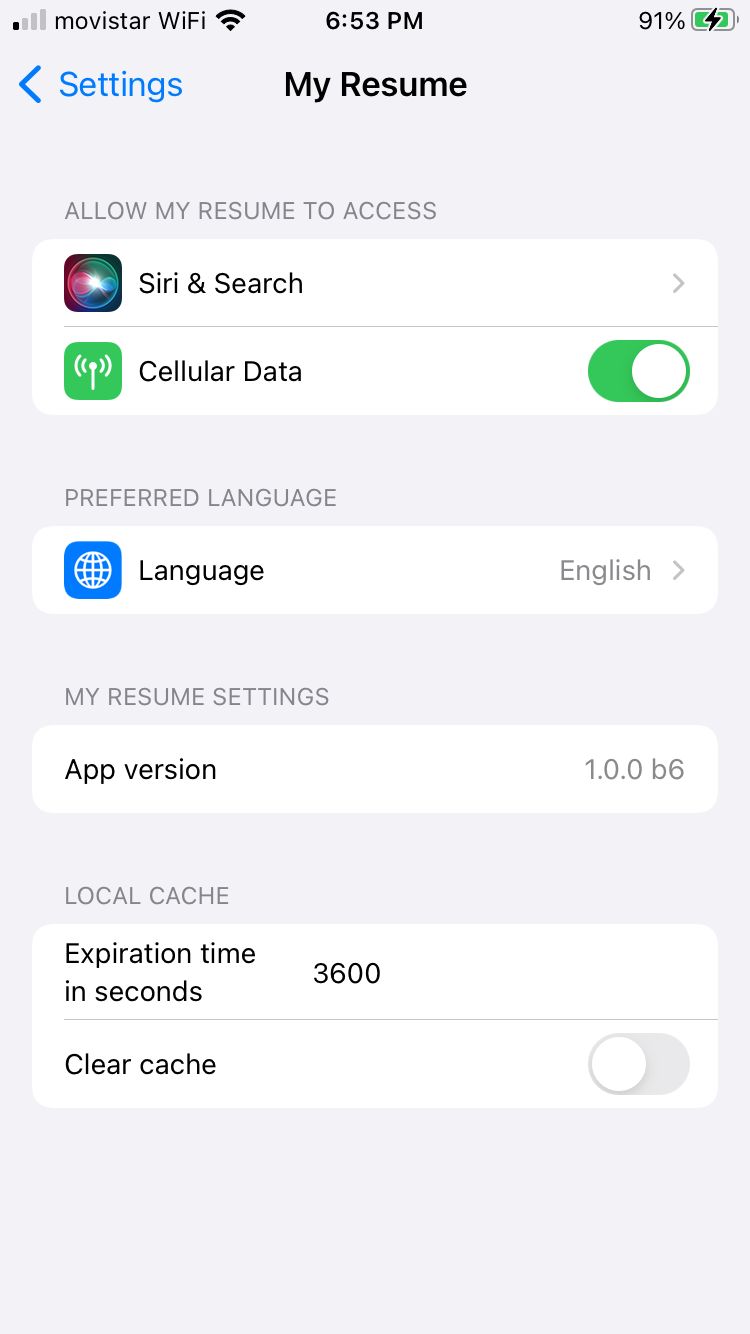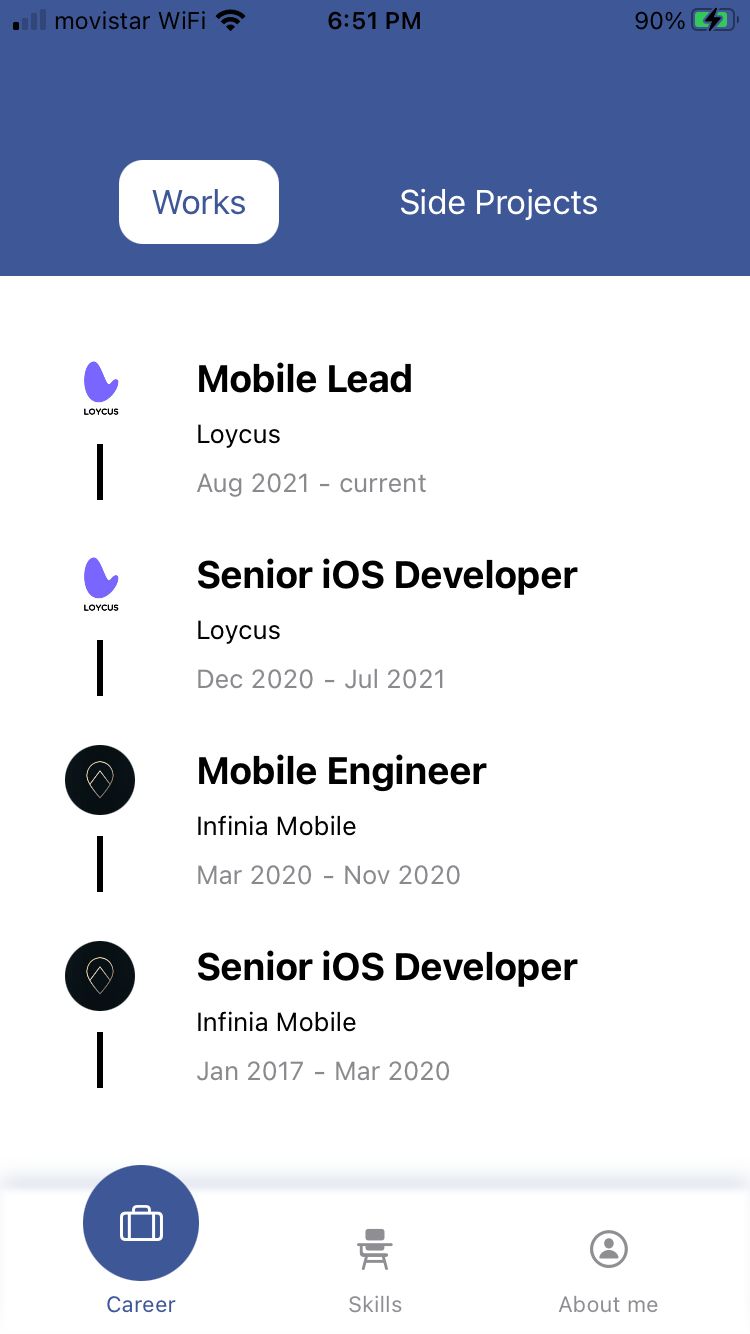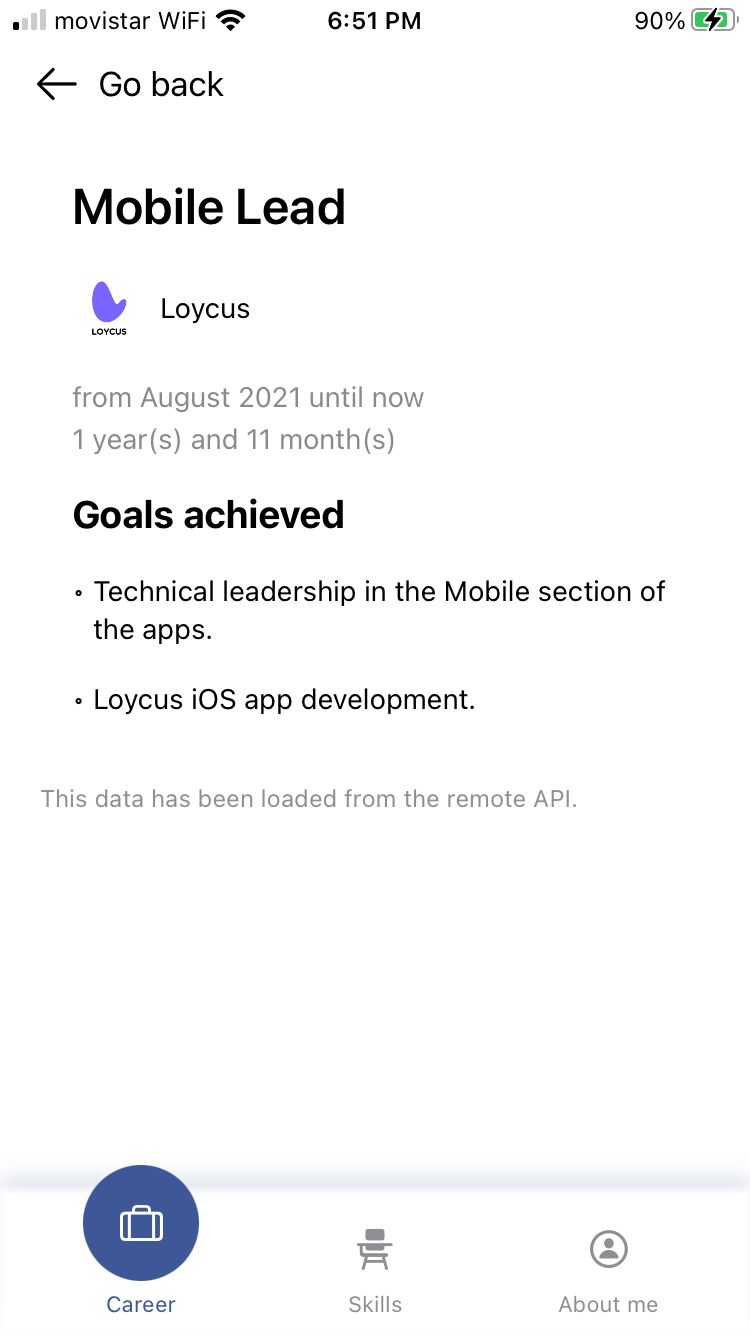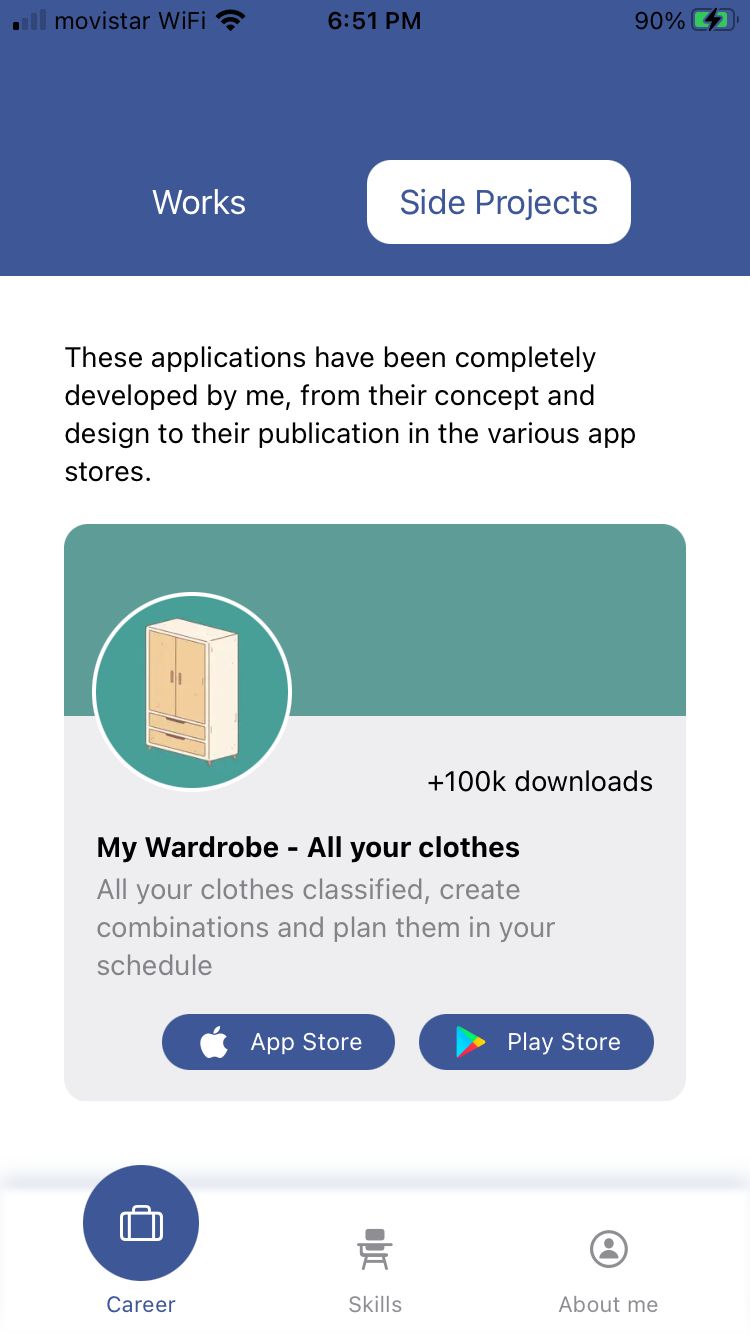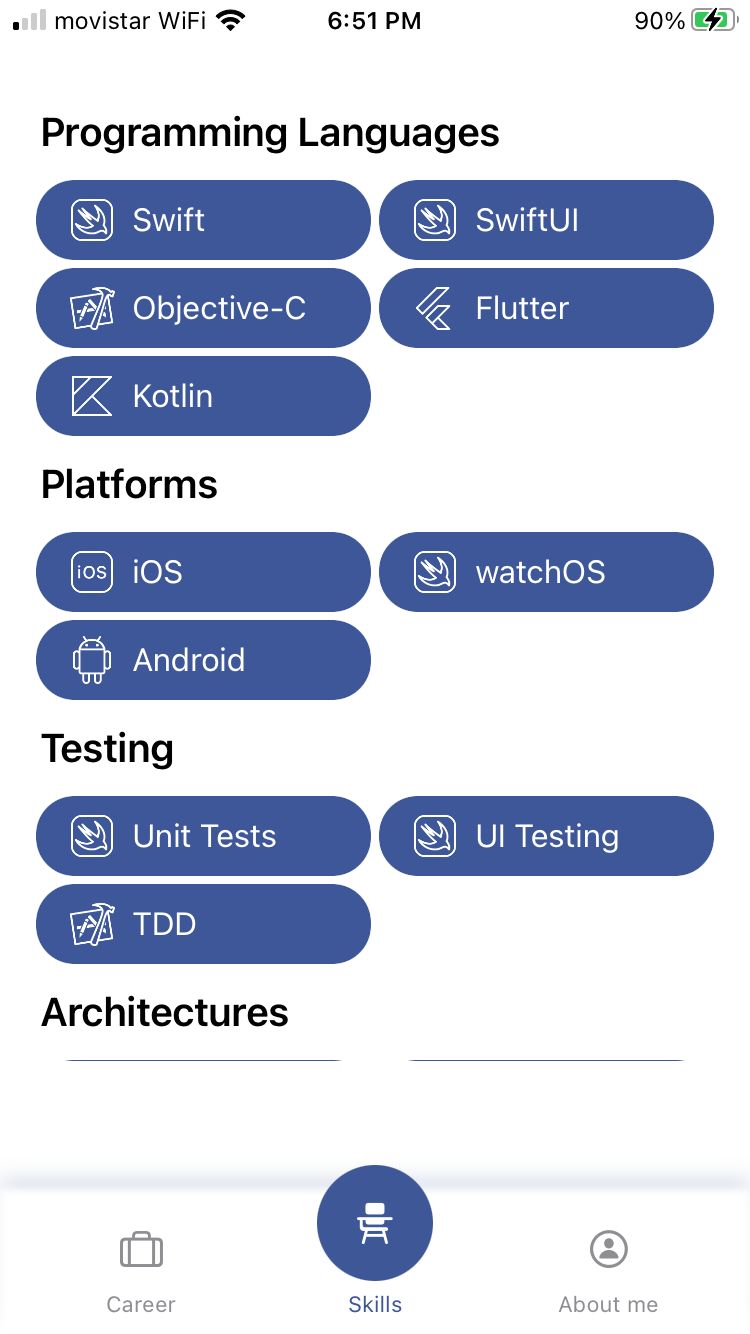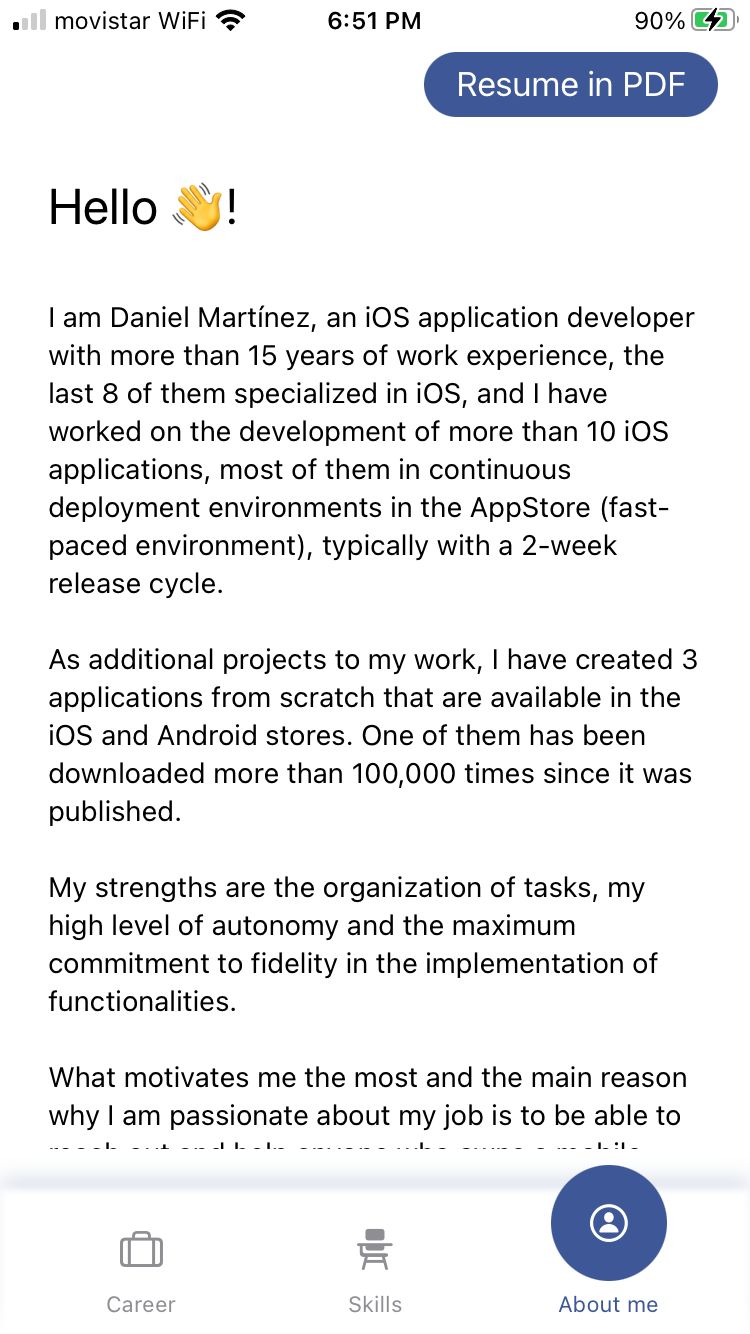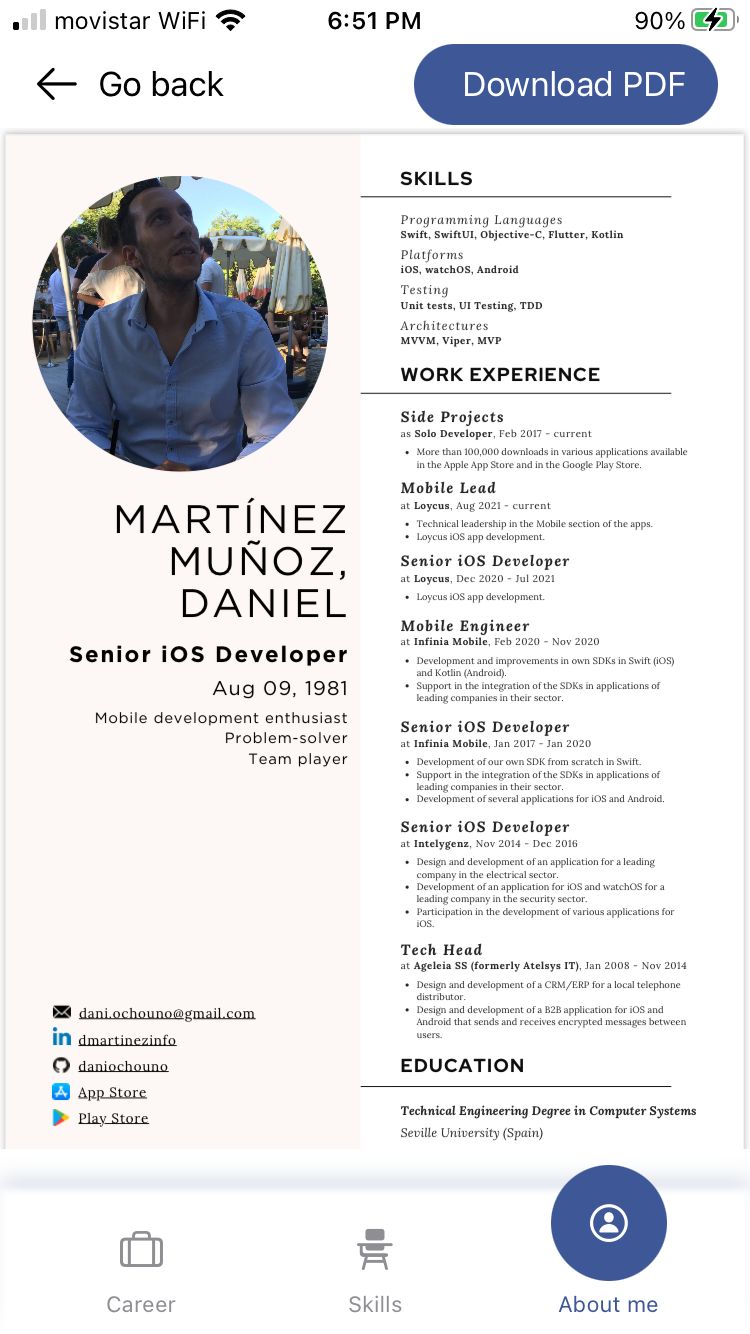I am Daniel Martínez, an iOS application developer with more than 15 years of work experience, the last 8 of them specialized in iOS, and I have worked on the development of more than 10 iOS applications, most of them in desktop environments. continuous deployment on the AppStore (fast-paced environment), typically with a 2-week release cycle.
As additional projects to my work, I have created 3 applications from scratch that are available in the iOS and Android stores. One of them has been downloaded more than 100,000 times since it was published.
My strengths are the organization of tasks, my high level of autonomy and the maximum commitment to fidelity in the implementation of functionalities.
What motivates me the most and the main reason why I am passionate about my job is to be able to reach out and help anyone who owns a mobile phone, an iPhone, with my apps.
I consider myself a good team worker, open to discuss the best way to develop a feature and collaborate to improve it.
This project was born to be able to show part of my skills as an iOS developer in a real and updated project.
I have used SwiftUI, UIKit, architectures like MVVM and VIPER, network connections to a REST API using Async/Await, etc... without using any external library, only with the APIs provided by Apple in its native SDK. The source code of this application is available for anyone interested to view.
Below I describe in detail how I have developed the project and how I have created each feature.
Throughout the development I have used TDD (Test Driven Development). This development technique consists of first writing the tests that will define the feature. In this phase, edge cases can be discovered that can condition the writing of the code that will later pass the tests.
Once the tests have been written, we move on to the next phase: writing the code that will fulfill the feature. Throughout this phase, the tests that we wrote previously will be launched to check the evolution of the development of the feature.
When all the tests pass, the feature can be finished.
I have used the Factory pattern throughout the project for the creation and initialization of the classes and, for example, to be able to use protocols throughout the different layers. Using this pattern has also made it easier to write tests, because it allows you to follow SOLID principles.
The minimum version supported is iOS 15. This allows me to use SwiftUI in an advanced state of stability.
All the texts that appear in the application are localized and are displayed in English (EN) or Spanish (ES) depending on the language of the device on which it is run. By default English is used.
Application data is stored in various collections in Firebase Firestore and it is stored in a local cache too.
I have split the project into different layers, following the principles of the Clean architecture:
Contains the databases, Data Sources, Repositories, and models used in this layer.
Contains the use cases and models used in this layer.
Contains the resources (Assets, localized text strings, etc...) and the views that are displayed in the application. Within this layer I have created a features folder where I have subdivided each screen/view and I have included its ViewModels, Models, Interactors, Presenters, etc... according to the architecture used in each feature.
In this layer I have included everything necessary to make the network connections. It is normally included in the Data layer, but I wanted to separate it to give it more importance.
I have created a protocol APIClient with a single method fetch that will be in charge of making the call to the REST API. In the method implementation I create a URLRequest with the request data and then call URLSession using Async/Await. I check that the response has a valid status (between 200 and 299) and parse the content to the data type expected in the response.
Here I have included the project configuration files and the necessary files for the Application Settings section, accessible from the operating system Settings.
Below I describe how I have developed each of the features/screens that I have included in the application.
The view is written in SwiftUI and has a 2-phase animation inspired by the initial animation of the Twitter app.
In the first one, the logo I've used for this app is shown growing and shrinking for 5 seconds with a scaling effect, where each change between growing/decreasing lasts 0.65 seconds.
In the second, the logo grows until it completely covers the screen and lasts 1 second.
Afterwards, the navigation automatically takes place towards the main screen of the application.
I use a ViewModel to control the various phases of the animation.
The view is written in SwiftUI and contains a custom TabView with 3 options to view information about my career, skills, and other information about me.
The custom TabView includes an animation when navigating between the different items.
I use a ViewModel to initialize the settings in the Settings.bundle when the screen is opened.
The view is written in SwiftUI and contains a top menu with 2 options: my works and my personal projects.
This feature uses the MVVM architecture.
The view is written in SwiftUI and displays a listing of my work and professional experience. At the end of the list, a text is shown indicating whether the information has been loaded from the remote API or from the cache.
I use a ViewModel to load the information. This ViewModel makes a call to the use case that gets the data model which is then parsed to get the model of the view.
The use case (domain layer) loads the list of jobs from the data layer repository and sorts them by job start date.
The repository has the logic of loading the data. It is the repository that determines whether the data in the cache is still valid, and if not, loads it from the remote API. For cache data to be valid, it must exist in the cache and must have been saved on or after the current date minus the cache expiration time. This expiration time can be changed in the application settings and by default it is 3600 seconds (1 hour). To access the cache data I use the LocalCache data source, and to access the remote API data I use the Firebase Firestore data source. Every time the data is fetched from the remote API the local cache is updated.
Firestore API calls need to be authenticated. So the first time I make a call to authenticate and get the session data: access token, refresh token and expires in. When I get this data I store it in the local cache for the next calls, until the session data is no longer valid.
Both the LocalCache data source and the Session data source use UserDefaults to hold cache data.
This feature uses the MVVM architecture.
The view is written in SwiftUI and shows the detail of a job after having selected it in the list above. At the end of the list, a text is shown indicating whether the information has been loaded from the remote API or from the cache.
I use a ViewModel to load the information. This ViewModel makes a call to the use case that gets the data model which is then parsed to get the model of the view.
The use case (domain layer) loads all job data from the data layer repository.
The repository has the logic of loading the data. It is the repository that determines whether the data in the cache is still valid, and if not, loads it from the remote API. For cache data to be valid, it must exist in the cache and must have been saved on or after the current date minus the cache expiration time. This expiration time can be changed in the application settings and by default it is 3600 seconds (1 hour). To access the cache data I use the LocalCache data source, and to access the remote API data I use the Firebase Firestore data source. Every time the data is fetched from the remote API the local cache is updated.
Firestore API calls need to be authenticated. So the first time I make a call to authenticate and get the session data: access token, refresh token and expires in. When I get this data I store it in the local cache for the next calls, until the session data is no longer valid.
Both the LocalCache data source and the Session data source use UserDefaults to hold cache data.
This feature uses the VIPER architecture.
The view is written in SwiftUI and displays a list of my personal projects. At the end of the list, a text is shown indicating whether the information has been loaded from the remote API or from the cache.
I use a Presenter to load the information. This Presenter calls the Interactor and it is this that makes a call to the use case that obtains the data model that is later parsed to obtain the entities of the view.
The use case (domain layer) loads the list of personal projects from the data layer repository and sorts them by number of app downloads.
The repository has the logic of loading the data. It is the repository that determines whether the data in the cache is still valid, and if not, loads it from the remote API. For cache data to be valid, it must exist in the cache and must have been saved on or after the current date minus the cache expiration time. This expiration time can be changed in the application settings and by default it is 3600 seconds (1 hour). To access the cache data I use the LocalCache data source, and to access the remote API data I use the Firebase Firestore data source. Every time the data is fetched from the remote API the local cache is updated.
Firestore API calls need to be authenticated. So the first time I make a call to authenticate and get the session data: access token, refresh token and expires in. When I get this data I store it in the local cache for the next calls, until the session data is no longer valid.
Both the LocalCache data source and the Session data source use UserDefaults to hold cache data.
To access the detail of a personal project, use the Router.
This feature uses the MVVM architecture.
The view is written in SwiftUI and shows the detail of a personal project after having selected it in the list above. At the end of the list, a text is shown indicating whether the information has been loaded from the remote API or from the cache.
I use a ViewModel to load the information. This ViewModel makes a call to the use case that gets the data model which is then parsed to get the model of the view.
The use case (domain layer) loads all personal project data from the data layer repository.
The repository has the logic of loading the data. It is the repository that determines whether the data in the cache is still valid, and if not, loads it from the remote API. For cache data to be valid, it must exist in the cache and must have been saved on or after the current date minus the cache expiration time. This expiration time can be changed in the application settings and by default it is 3600 seconds (1 hour). To access the cache data I use the LocalCache data source, and to access the remote API data I use the Firebase Firestore data source. Every time the data is fetched from the remote API the local cache is updated.
Firestore API calls need to be authenticated. So the first time I make a call to authenticate and get the session data: access token, refresh token and expires in. When I get this data I store it in the local cache for the next calls, until the session data is no longer valid.
Both the LocalCache data source and the Session data source use UserDefaults to hold cache data.
This feature uses the MVVM architecture.
The view is written in UIKit and displays a grouped listing of my professional skills. To display the view I have created a Storyboard which contains a UICollectionView. This CollectionView has a cell type of UICollectionViewCell to display the text that defines the skill along with its icon. Also, there is a UICollectionReusableView that I use to display the category headers.
To integrate this view into UIKit in the rest of the app, which uses SwiftUI, I've created a UIViewControllerRepresentable that encapsulates it.
I use a ViewModel to load the information. This ViewModel makes a call to the use case that gets the data model which is then parsed to get the model of the view.
The use case (domain layer) loads the list of professional skills from the data layer repository.
The repository loads the data from the Json data source. Because it is a local file there is no need to establish a cache mechanism to access the data, so it is always loaded directly from the JSON.
The Json__ __data source reads the JSON file from the database and parses its content.
The view is written in SwiftUI and displays various texts with information about me and this project.
The view is written in SwiftUI and displays a PDF of my resume. To display it I use the Apple API PDFKit. Since PDFKit uses UIKit, I use a UIViewRepresentable to display it in the SwiftUI view.
In addition, I have added a button at the top that allows you to share the PDF file that is being viewed.











